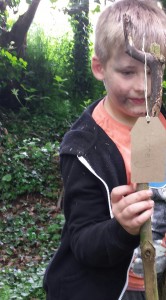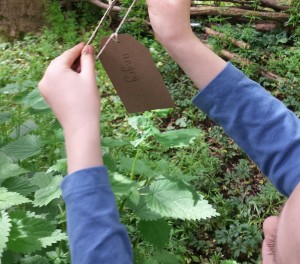In Key Stage 2 children start to think in more depth about how writers use figurative language to create effect in their writing. Personification has the potential to be such an obscure concept for children with, “personi-whatsit,” being something I overheard recently. Teaching this outside allows for far greater understanding, as children can truly experience the meaning.
In my bag of supplies, I always carry luggage labels with me, and they come in handy when teaching personification. The children can be given words or asked to write words themselves, connected with human emotions or actions. This can be done as an introductory activity, or as a reinforcement of previous learning. The labels can be written on and hung on, or (if that’s not possible) near the relevant object. I sometimes use laminated pieces of white card, as these can be hole-punched and threaded with string. They can then be written on with whiteboard markers and used over again. Luggage labels and pencil/pencil crayon are my top choice though, as the words are more likely to stay on if it rains, and they can be taken inside after, to act as a transferrable reminder of the work done outside.
A Y4 boy who had labelled a stick, told me a whole back story as to why the stick was lonely, including the way it, “stood awkwardly.” Another child explained to me why the nettles were angry, and went on to putting it into a structured sentence without prompting. Someone else talked about how the sun was smiling, and when I asked why replied, “because the flowers are dancing!” 
The outdoors can give us an emotional connection with our surroundings; it is an invaluable resource when wanting to give the children an understanding of figurative language. I love the richness of language that being outdoors can conjure, when given the opportunity. When I am working outside with the children, I am constantly modelling figurative language, whether I am teaching it that day or not. Using the outdoors as a vehicle for this technique, cements the children’s understanding through language, experience and context.



Thank you for posting again. I absolutely love reading your ideas and am definitely going to try this out with a group of reluctant boy writers. I would never have thought to introduce personification like this and the responses from the children are incredible. This would inspire children to write some amazing woodland poems. Are you considering writing a book ? You really draw the reader in and inspire the reader to try the ideas out. Keep posting – I love this Blog !
Thank you so much for your message Katie. It’s lovely to hear from a reader. I would love to hear what happens when you try this out with your reluctant boys.
I completly agree with you about the emotional connection we have with the ‘outside’ and how this leads to children developing their language and understanding. I wonder if it all taps into something deep within us, seeing as up until recently we have had such a connection with the land and nature.
Hi Catherine,
Yes I think you’re right, and hopefully the relevance and importance of that connection is starting to be realised more and more. Have you read, ‘ Last Child in the Woods’ by Richard Louv? There is some research in the latest edition, confirming the impact that direct exposure to nature has on emotional health.